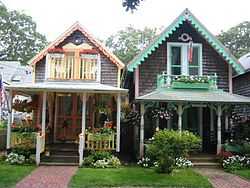Wesleyan Grove
|
Wesleyan Grove | |
 | |
|
Two ornate cottages on the campground site. | |
| Location | Oak Bluffs, Massachusetts |
|---|---|
| Governing body | Private |
| NRHP Reference # | 05000458 |
| Significant dates | |
| Added to NRHP | April 5, 2005[1] |
| Designated NHLD | April 5, 2005[2] |
|
Martha's Vineyard Campground | |
 | |
| Location | Roughly bounded by Cottage Park, Quequechan, Clinton, Dukes, County, Siloam, Lake, and Central Aves., Oak Bluffs, Massachusetts |
|---|---|
| Coordinates | 41°27′19″N 70°33′41″W / 41.45528°N 70.56139°WCoordinates: 41°27′19″N 70°33′41″W / 41.45528°N 70.56139°W |
| Built | 1835 |
| Architect | Multiple |
| Architectural style | Late Gothic Revival, Gothic, Gothic Revival |
| Governing body | Private |
| NRHP Reference # | 78000439 |
| Added to NRHP | December 14, 1978[1] |

History
Just after the American Civil War, the area developed as a large Methodist summer campground with open air Christian revivals. This meeting style became popular around the United States at the time, and many other similar camps were founded using similar models, such as Ocean Park, Maine and Ocean Grove, New Jersey. Colorful, ornate, gingerbread cottages were built in an oak grove around a central church tabernacle. The grove was added to the National Register of Historic Places and was further declared a National Historic Landmark in 2005.[2][1]
The first campmeeting in what became known as Wesleyan Grove was held in 1835. In subsequent years the congregations grew enormously, and many of the thousands in attendance were housed in large tents known as "society tents." A congregation from a church on the mainland would maintain its own society tent. Conditions were cramped, with men and women sleeping dormitory-style on opposite sides of a central canvas divider. Society tents were arranged in a semicircle on Trinity Park. Over time, families began leasing small lots on which to pitch their own individual tents. In the 1860s and 1870s, the family tents were rapidly replaced with permanent wooden cottages. At one time there were about 500 cottages; today there are just over 300. Many eminent members of the clergy from across the country have preached at the campmeetings in Wesleyan Grove. That tradition continues today, although services are no longer held day and night as they were in the early years. Over time the MVCMA has become increasingly interdenominational, and the current members of the Board of Directors are affiliated with a wide variety of Christian groups. The religious services and special programs of the Association all have a strong ecumenical spirit. Today the Campground is a community of summer residents and a smaller number of year-round residents who value the intimacy created by the crowding of cottages on small tent lots. Many of the cottages have been owned by the same families for generations. The residents of the Campground have a keen appreciation for the special traditions of which they are a part.

See also
References
- ↑ 1.0 1.1 1.2 1.3 "National Register Information System". National Register of Historic Places. National Park Service. 2008-04-15.
- ↑ 2.0 2.1 "Wesleyan Grove". National Historic Landmark summary listing. National Park Service. Retrieved 2008-09-13.
| ||||||||||||||||||||||||||||||||||||||||
